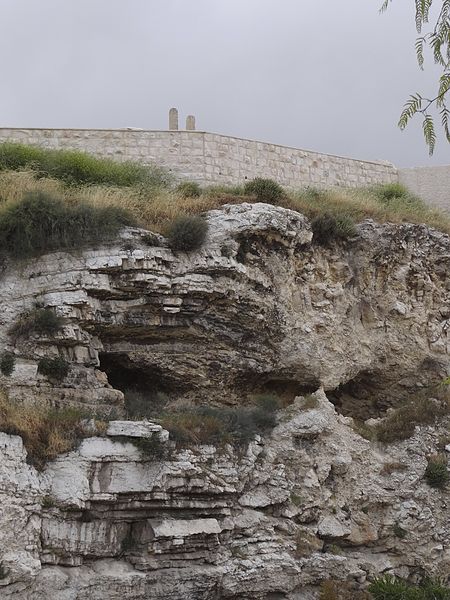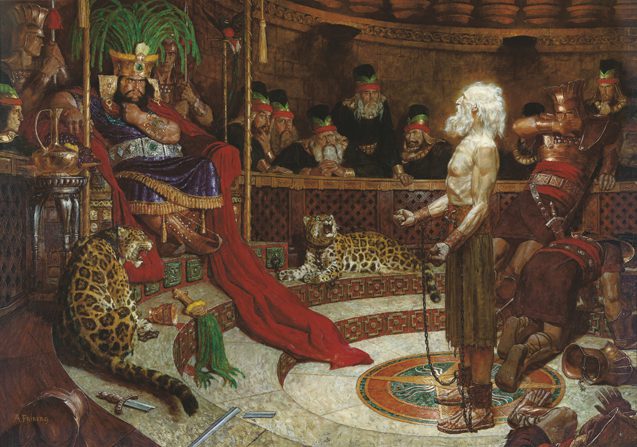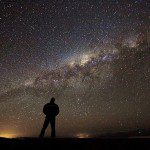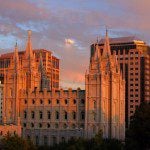
(Wikimedia Commons public domain photograph)
I’m not absolutely committed to the idea of making Good Friday a legal holiday, but I’m certainly not opposed to it. And making a three-day holiday of Easter weekend seems to me not a bad idea, although many if not most people would presumably use it for waterskiing or a gambling escape to Reno or LasVegas or something of that sort. But I’m strongly in favor of the idea of putting more emphasis on Easter — or on what Claudia Bushman prefers (with good reason) to call “Resurrection Day.”
I’ve said it before: It would be very difficult for me to choose, if I had to choose, whether Christmas or Easter is the more important holiday. Obviously, if it were not for the advent of Christ, the event commemorated at Christmas, there would be no Easter. And, just as surely, if there were no atonement and resurrection, the events that we commemorate at Easter, there would be no particular point to Christmas. Millions of babies are born every year. So why celebrate the birth of that one, two thousand years ago in an obscure corner of a far away place?
However, if I really did have to choose between them, I would rank Easter as more fundamentally important than Christmas. Christianity is, I think, fundamentally an Easter faith. If Mary’s baby hadn’t grown up to do at least a couple of, well, remarkable things — things like, umm, atoning for our sins and rising from the tomb to break the bonds of death — I, at least, probably wouldn’t attend church very often.
And, accordingly, I’ve always been bothered by the fact that, while Christmas receives weeks and weeks of carols and celebrations, Easter often barely gets a Sunday (even, or perhaps especially, in my own church). So I would very happy if we were to extend our notice of “the Easter event” (as certain theologians have sometimes called it), and our celebration of it, and, most importantly, our reflections on it, over more than one day. Good Friday is a potentially wonderful way of encouraging such reflections.

A new article was published today in Interpreter: A Journal of Latter-day Saint Faith and Scholarship: “The Literary Structure of Alma 23–27,” written by
Abstract: This article presents a macro-chiasm for Alma 23:16 through Alma 27:30 that covers the account of the people of Anti-Nephi-Lehi from the time they first take upon themselves that name to the time they relocate to the Nephite land of Jershon and are subsequently called the people of Ammon. The central element of this chiasm highlights the martyrdom of some Lamanite believers in the wilderness by the hand of the seed of Amulon in fulfillment of Abinadi’s prophecy in Mosiah 17:15. The meaning behind this puzzling prophecy may be illuminated by analyzing the structure of this macro-chiasm. It underscores the role Alma 26 plays as a strategic interruption in the narrative, much like how Alma 36–42 disrupts the story of the Zoramites. Events within the account of the people of Anti-Nephi-Lehi were carefully crafted by Mormon and purposefully placed within the narrative to form a memorable foundation story justifying the acceptance and integration of the people of Ammon into Nephite society both religiously and politically. The same criteria previously used to measure the strength of a proposed chiasm are employed here.
And this also went up, on the Interpreter Foundation website: “Interpreting Interpreter: A Martyrdom-Based Macro-Chiasm,” written by Kyler Rasmussen:
This post is a summary of the article “The Literary Structure of Alma 23–27” by Derek Squire in Volume 64 of Interpreter: A Journal of Latter-day Saint Faith and Scholarship. All of the Interpreting Interpreterarticles may be seen at https://interpreterfoundation.org/category/summaries/. An introduction to the Interpreting Interpreter series is available at https://interpreterfoundation.org/interpreting-interpreter-on-abstracting-thought/.
A video introduction to this Interpreter article is now available on all of our social media channels, including on YouTube at https://youtube.com/shorts/2DWSHHv_8LU.
The Takeaway: Squire proposes a macro-chiasm that spans Alma 23:16 to Alma 27:30, suggesting that it helps establish a connection between Abinadi—whose prophecy of the deaths of Amulon’s seed saw fulfillment in that passage—and the martyred Lamanite converts the chiasm describes, each dying by fire because of their faith. He also identifies several micro-chiasms within the larger structure that reinforce similar themes.

I recently did a podcast with Scott Woodward and Casey Griffiths about the Witnesses to the Book of Mormon. It’s up now. It runs about 84 minutes in length, and it’s available in two versions:
“What You Haven’t Heard About the Gold Plates Witnesses, with Daniel Peterson” (video)
And here’s something else, new yesterday on the website of the Interpreter Foundation: Episode 24: What was Joseph’s Witness?
Witnesses of the Book of Mormon—Insights Episode 24: When we discuss the witnesses of the Book of Mormon, we often overlook the first witness of the plates: Joseph Smith himself. What were his experiences with the plates? This is Episode 24 of a series compiled from the many interviews conducted during the course of the Witnesses film project. . . . These additional resources are hosted by Camrey Bagley Fox, who played Emma Smith in Witnesses, as she introduces and visits with a variety of experts. These individuals answer questions or address accusations against the witnesses, also helping viewers understand the context of the times in which the witnesses lived. This week we feature Daniel C. Peterson, President of the Interpreter Foundation and Executive Producer of Witnesses. For more information, go to https://witnessesofthebookofmormon.org/. Learn about the documentary movie Undaunted—Witnesses of the Book of Mormon at https://witnessesundaunted.com/.
In fact, that documentary, Undaunted, is now available for unlimited free streaming, both domestically and beyond the United States. As is Witnesses itself, although only through the end of February. For the relevant links, go to The Witnesses Initiative.

Finally, it is my woeful duty to bring to your attention yet another horror from the Christopher Hitchens Memorial “How Religion Poisons Everything” File™. See how theists exploit even young children for their nefarious ends: “Primary service initiative an important invitation and sacred opportunity for children: Primary general presidency expounds on how children can plan, invite and serve beginning in 2025”











